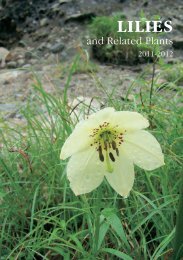LILIES - RHS Lily Group
LILIES - RHS Lily Group
LILIES - RHS Lily Group
Create successful ePaper yourself
Turn your PDF publications into a flip-book with our unique Google optimized e-Paper software.
var. abeanum is a case in point, or perhaps L. japonicum Hyuga form. Other<br />
lily communities have certainly been destroyed by developments such as dam<br />
construction, road building and estate development. However, it must have been<br />
often the case that habitats are dying through environmental changes such as<br />
those which result from failure to trim grassland and forestry in the old ways. It<br />
can be said that L. auratum, L. callosum, L. japonicum and L. rubellum are the<br />
species whose existence in Japan has been influenced most by human lives.<br />
The Okinawa population of Lilium callosum (a population known from its<br />
yellow flowers as var. flaviflorum) was rediscovered for the first time in these<br />
20 years. Yet it has already fallen victim to changing times, with changes in its<br />
habitat management. The island is in “Typhoon alley”, and the thatch which has<br />
been traditional for roofing material there has now given way to concrete. So<br />
grassland has been neglected, allowing over-abundant growth of Japanese silver<br />
grass over two metres in height, destroying almost all the lily’s habitats. On a visit<br />
last year we found just one population of 50 plants, where Imperata cylindrica<br />
grassland had been artificially weakened. As far as I know there is only one other<br />
population on the island now.<br />
Lilium nobilissimum was endemic to Kuchinoshima island, Kagoshima<br />
Prefecture, where its habitat was restricted to the ocean cliff. Lilium nobilissimum’s<br />
Japanese name is Tamoto-yuri: Tamoto is the pouch-forming sleeve of Japanese<br />
clothing, and in the past men lowered on a bamboo contraption slung from the<br />
cliff-top to gathered the bulbs of the lily kept them in this pouch. This precarious<br />
undertaking seems to have been all too successful: the lily is said to be extinct<br />
in the wild now. A few cultivated plants preserve the species. However, in our<br />
Yurigahara Park collection this lily’s germination rate has now declined to about<br />
20%, which I think must be caused by inbreeding depression. Although we will<br />
outbreed the strain with another strain next summer, I am not very hopeful for<br />
the future, over the next several generations. [Editor’s note: This lily is also in<br />
cultivation in the UK, and perhaps elsewhere, but from seed kindly donated<br />
to the <strong>Lily</strong> <strong>Group</strong> distribution by Mr Arakawa in the past, so these plants are<br />
unlikely to help with the inbreeding problem.]<br />
Lilium alexandrae ranges over three islands of this same southern chain.<br />
Though it has been reduced by collection, it is sustained in the wild by the<br />
islander’s keen conservation work.<br />
The only surviving habitats of L. concolor are now confined to Shikoku Island,<br />
and the wild population declines.<br />
Lilium longiflorum, L. leichtlinii var. maximowiczii, L. speciosum, L. maculatum<br />
and L. medeoloides are common lilies in their original habitats, through exemplary<br />
preservation and conservation – a textbook case.<br />
14




